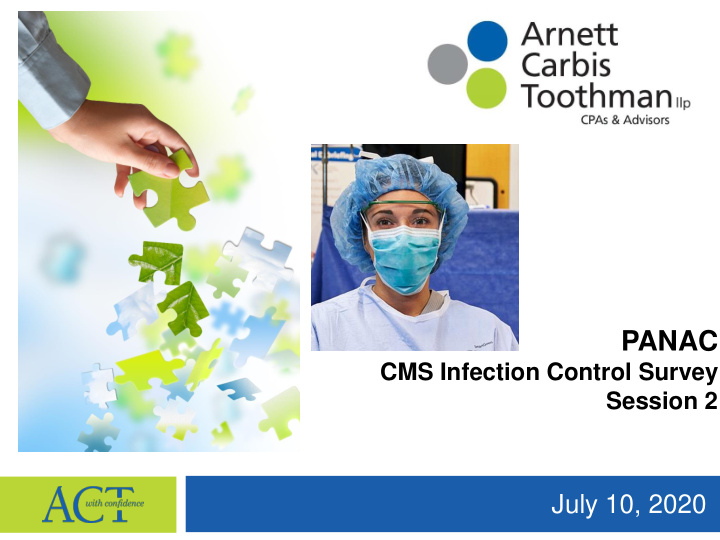



PANAC CMS Infection Control Survey Session 2 July 10, 2020
Infection Prevention & Preparation 7/02/2020 – Part 1 – Do you have all the pieces in place for a successful survey outcome? Review of Infection Control Survey process and components. 7/10/2020 – Part 2 – Use of tools and best practices to promote and monitor for compliance with Infection Control related to COVID-19. 2
Safe ICP Practices Whose job is it? Infection Preventionist …… Everyone 3
Action Items = Compliance Systems that follow guidelines and/or best practices Staff education Supplies Monitoring practices Collecting and analyzing data Begin at the beginning 4
Happy Birthday to You… 5
Hand Hygiene Alcohol-Based Hand Rub (ABHR) dispensers are located at facility entrances ABHR is accessible in all resident care areas Do not rinse or wipe off the hand sanitizer before it’s dry – 20 seconds Soap dispensers & disposable hand towels 6
Hand Hygiene COVID-19 Observations Prior to donning gloves and PPE Before & after performing personal cares After handling soiled items Before handling resident food Before handling resident care devices After touching facemask or goggles 7
5 Moments for Hand Hygiene Before Patient Contact 1. What’s on your hands? ▪ Before an Aseptic Task 2. Patient’s own germs ▪ After Body Fluid Exposure Risk 3. Glove removal ▪ After Patient Contact 4. After Contact with Patient Surroundings 5. 8
Respiratory Hygiene/Cough Etiquette Cover the nose and mouth when coughing or sneezing Use tissues to contain respiratory secretions Use elbow Hand hygiene 9
Education, Monitoring & Screening Self-monitor Temperature of 100.0F Selection and use of PPE Facemasks Social distancing in break rooms 10
Visitor Restrictions All visitors should have temperature and symptom screening Ill visitors or visitors with a temperature should not enter Hand hygiene Cloth face covering Designate a single entrance for visitors 11
Cohorting of Residents Actively monitor upon admission Restrictions Dedicated space and Staff COVID-19 and 14 ALL PPE 12
Return to Work Criteria COVID-19 Symptom Based Strategy At least 3 days have passed since recovery AND At least 10 days have passed since symptoms first appeared Test Based Strategy Resolution of fever without the use of fever reducing meds AND Improvement in respiratory symptoms AND Negative results from at least two consecutive respiratory specimens 13
Return to Work Criteria COVID-19 Time Based Strategy 10 days have passed since first positive test If symptoms develop then use symptom based or test based strategy Test Based Strategy Negative results from at least two consecutive respiratory specimens 14
Resident Education Encouraged to remain in their rooms Hand hygiene Social distancing Monitoring x3 15
OCD: The only way to clean properly… 16
Cleaning Considerations Contact Time EPA List N Shared Equipment High-touch Surfaces 17
Communication Best Practices Families & Residents Automated Voice Messages Dedicated “info” email address and voice mail Resident Meetings Staff COVID-19 Bulletin Boards Staff Only Section on Website Printed Documentation Tell Their Story 18
Education Best Practices Let Super Stars Shine Train Champions Divide and Conquer Stations When & What Orientation PPE HH 19
MASK OUT COVID: How to Wear Your Facemask the Safe, Smart Way When worn properly, a facemask is an important way to prevent the spread of COVID-19. THE RIGHT WAY THE WRONG WAY Make sure your facemask Don’t touch the outside completely covers your nose of your mask while you and mouth and is secured are wearing it. snugly under your chin. Wash your hands before Don’t reuse disposable you put on, and after you masks. Throw away take off, your mask. after single use. Touch only the ties or ear Don’t wear a mask that’s loops when putting on or too loose or slides down taking off your facemask. your face. If your mask has a metal wire Don’t lower your mask so running along the top edge, you can talk. mold it over the bridge of your nose to help contain droplets. Don’t rest your mask Launder your cloth facemask between uses, around your neck or under your chin. especially when visibly soiled. Don’t hang your mask off Store masks in a clean your ear. environment. For more information, review the CDC’s recommendations HERE The Association for Professionals in Infection Control and Epidemiology (APIC) is creating a safer world through the prevention of infection. APIC’s nearly 16,000 members develop and direct infection prevention and control programs that save lives and improve the bottom line for healthcare facilities. APIC advances its mission through patient safety, education, implementation science, com- petencies and certification, advocacy, anddatastandardization. Visit us at apic.org. | AR L I NG TO N, VI R G I NI A 2 2 2 0 2 | www.apic.org 1 4 0 0 C R Y S TAL DR I VE, S U I T E 9 0 0
QAPI Best Practices System Audits PPE use, handling, storage Environmental cleaning Kitchen & Dining room sanitation Screening 21
COVID-19 Focus Survey Recap Resident Care Observations: Hand Hygiene Practices Proper use/discard of PPE Cleansing Medical Equipment Effective Transmission-Based Precautions Environmental Observations: Signage at Entrances and Resident Rooms Screening Hand Hygiene Stations 22
COVID-19 Focus Survey Recap Interviews with Relevant Staff: Policy/Procedure Knowledge Surveillance for Signs/Symptoms Notifying Local Health Officials Information Provided Offsite Activities: Medical Records Review Telephone Interviews Facility Policy/Procedure Reviews Review Communications 23
Infection Control Resources CDC Infection Prevention Resources for Long- term Care: http://www.cdc.gov/longtermcare Hand Hygiene in Healthcare Settings: http://www.cdc.gov/handhygiene Guidance for the Selection and Use of PPE: http://www.cdc.gov/HAI/prevent/ppe.html Respiratory Hygiene and Cough Etiquette in Healthcare Settings: http://www.cdc.gov/flyu/professionals/infection control/resphygiene.htm 24
Infection Control Resources Guidelines for Environmental Infection Control in Healthcare Facilities: http://www.cdc.gov/hicpac/pdf/guidelines/eic in HCF 03.pdf Options for Evaluating Environmental Infection Control: http://www.cdc.gov?HAI/toolkits/Evaluating- Environmental-Cleaning.html 25
26
Thank you! Ca Candy y San Sanchez, , RN, RN, NHA, A, IPCO IPCO, , CD CDP De Dee Adk Adkins, ins, RN RN, , NHA, A, RA RAC-CT CT, , CD CDP Manager – Health Care Services Senior Manager – Health Care Services e-mail: Candy.Sanchez@actcpas.com e-mail: Dee.Adkins@actcpas.com voice: 304.346.0441 or 800.642.3601 Connect with ACT: 27
Recommend
More recommend